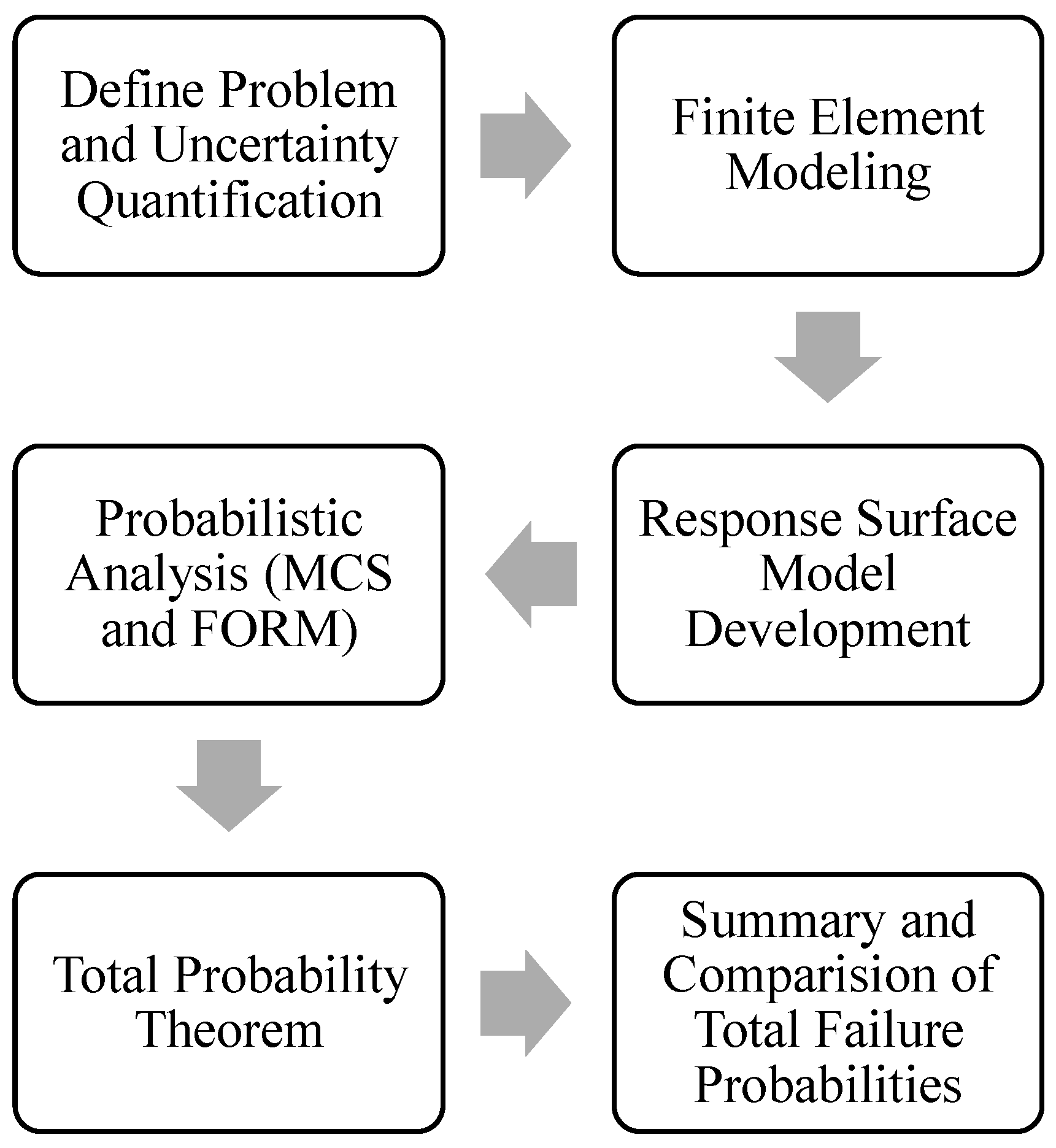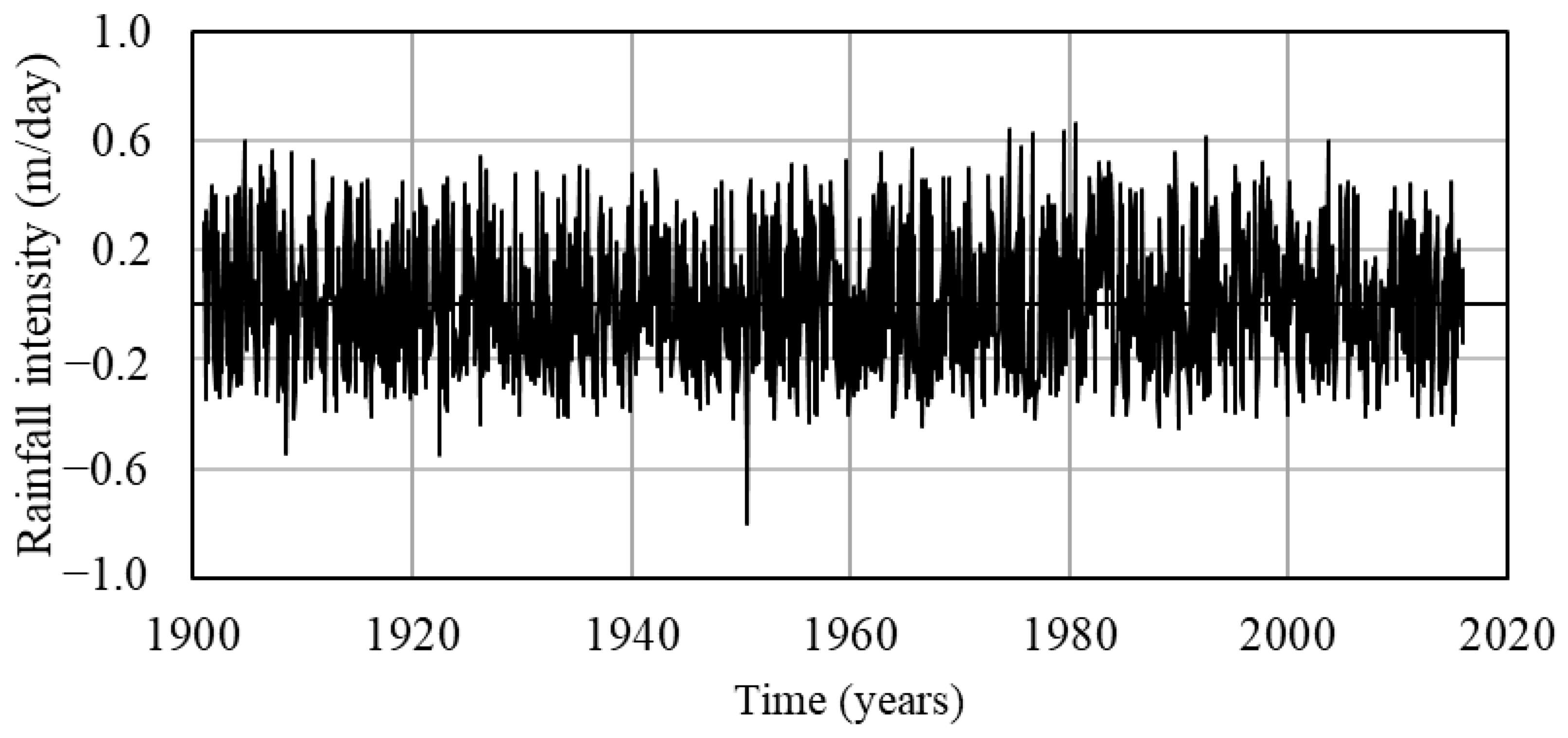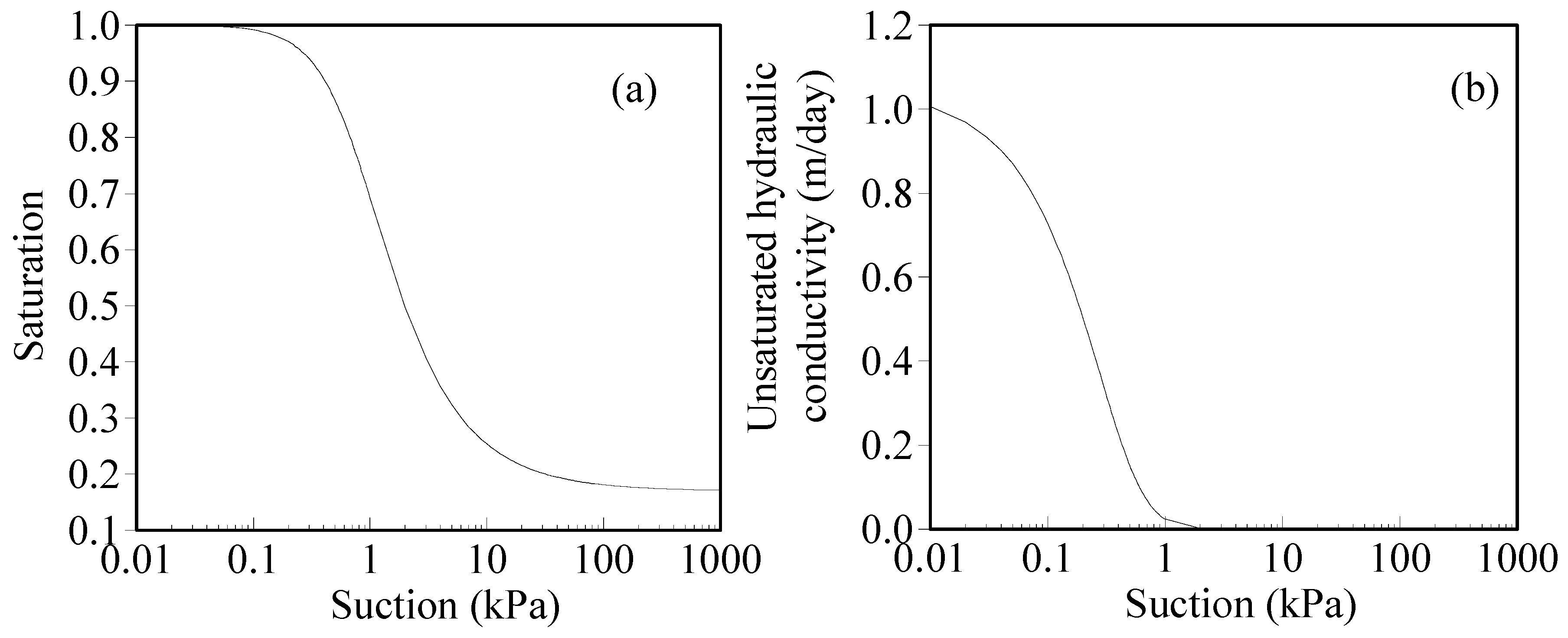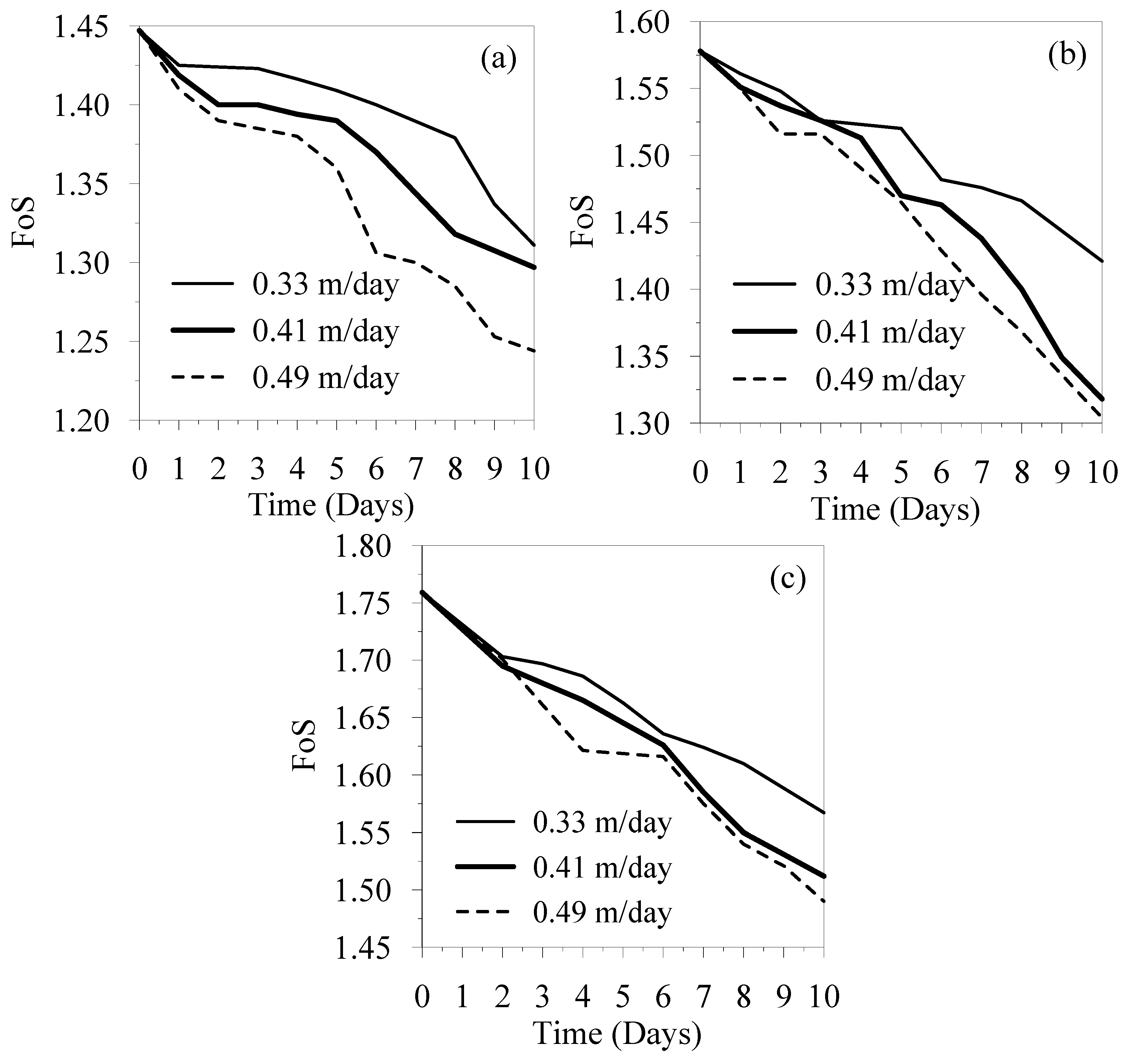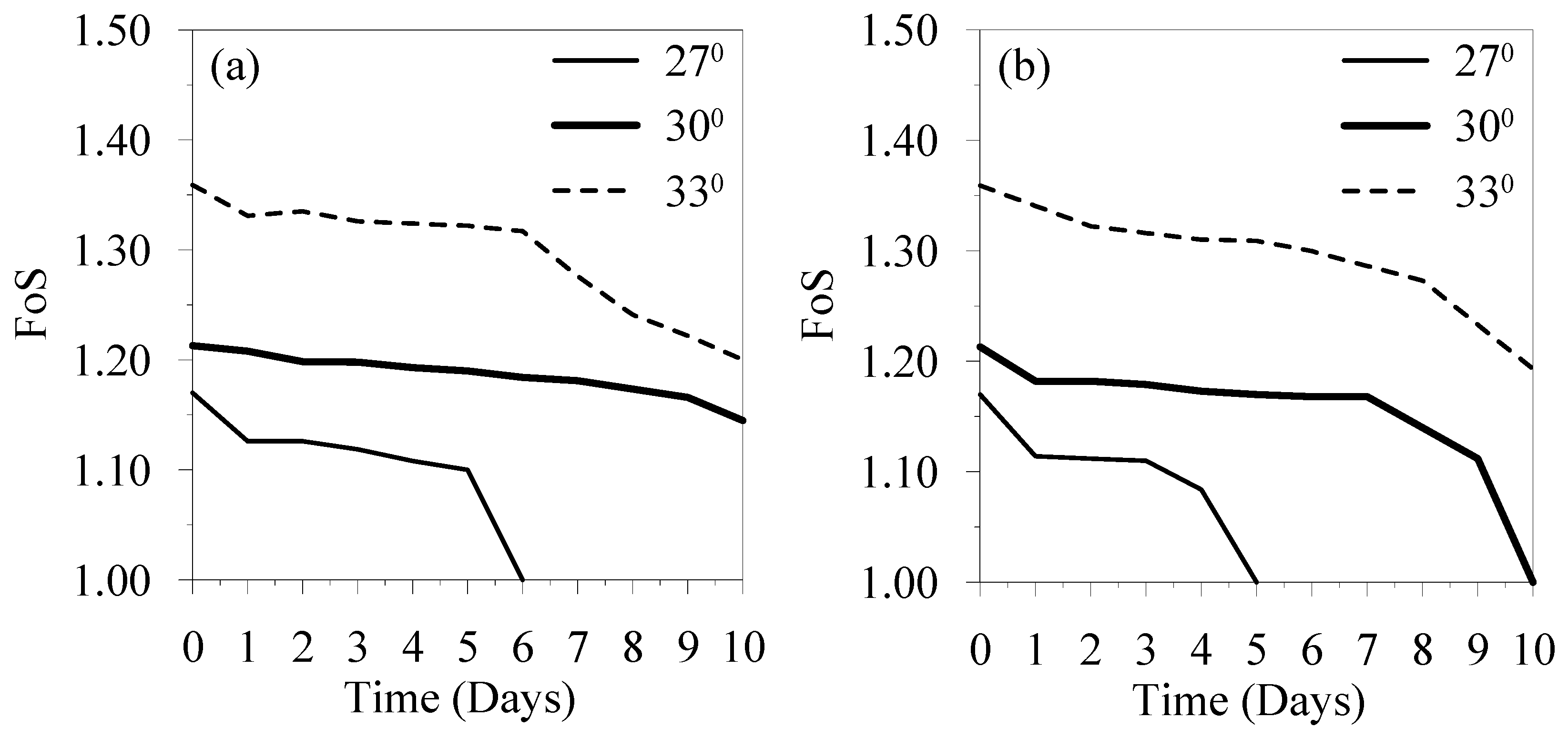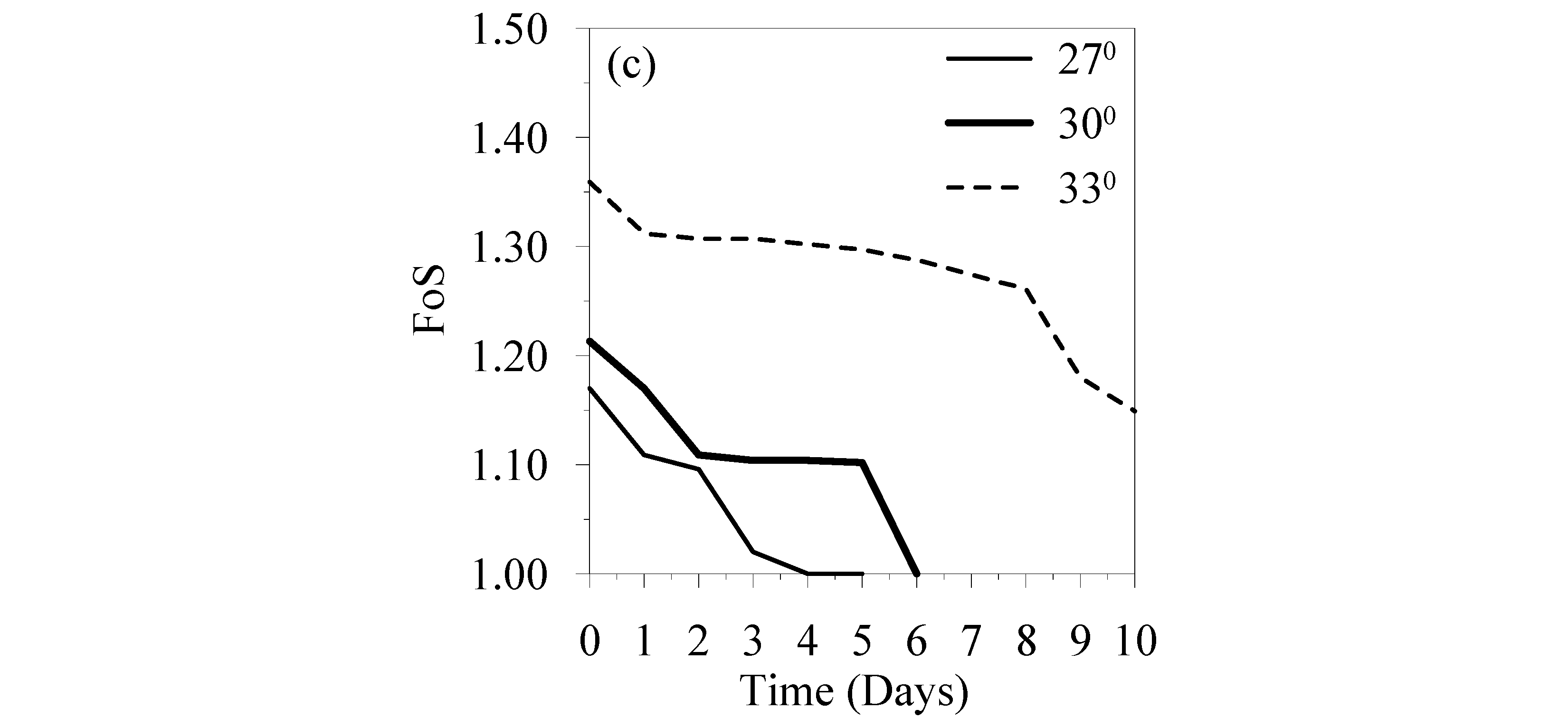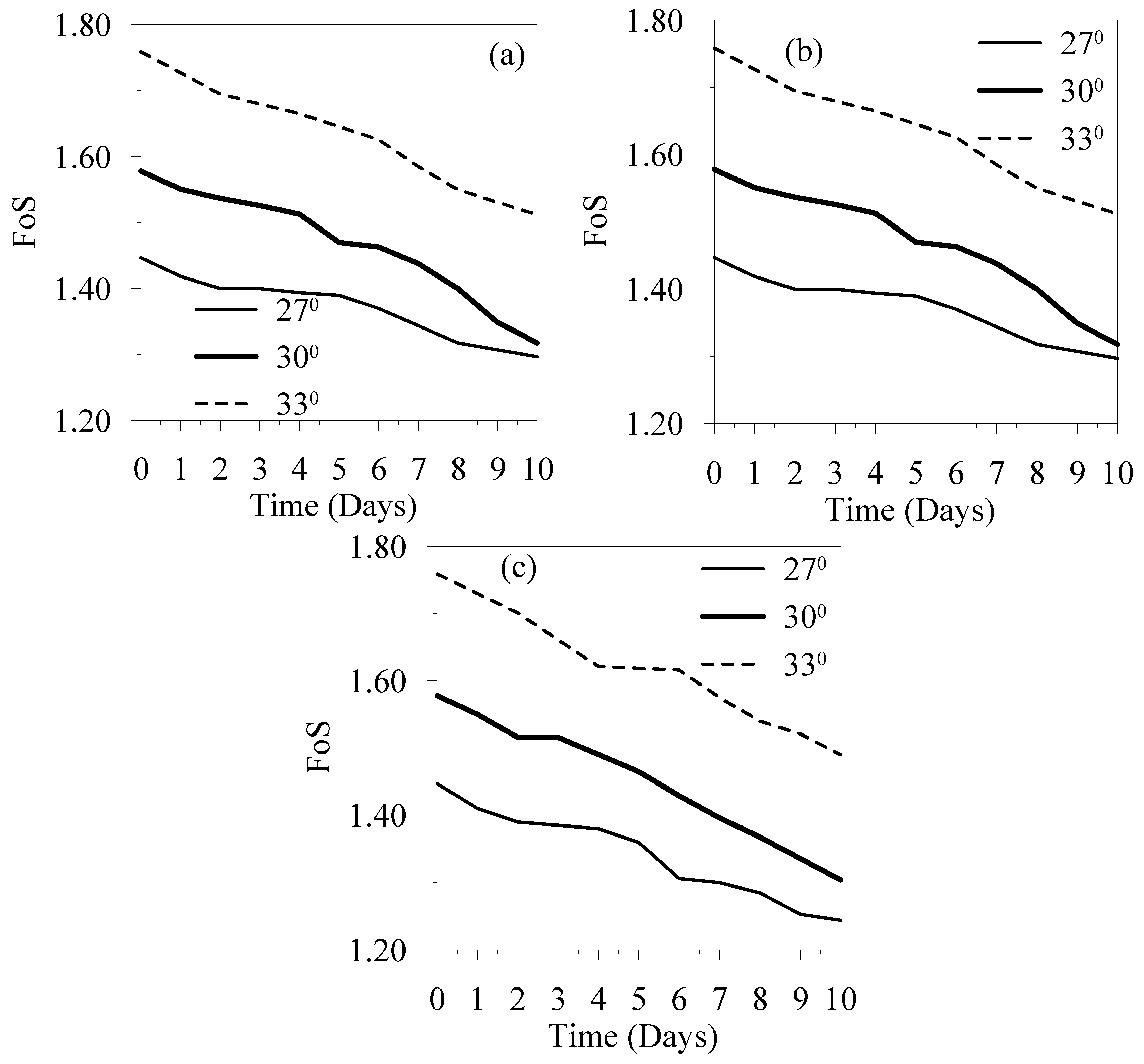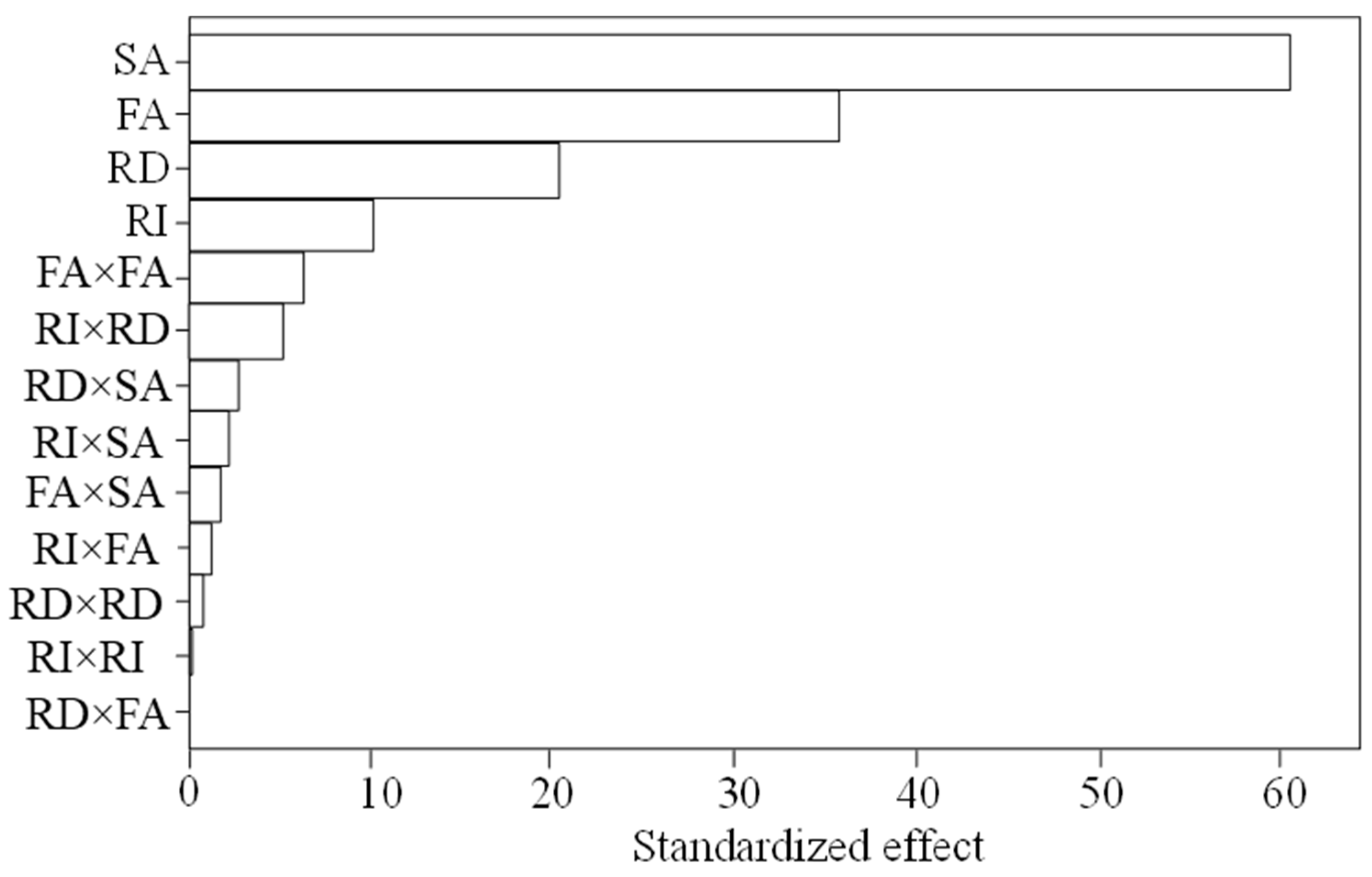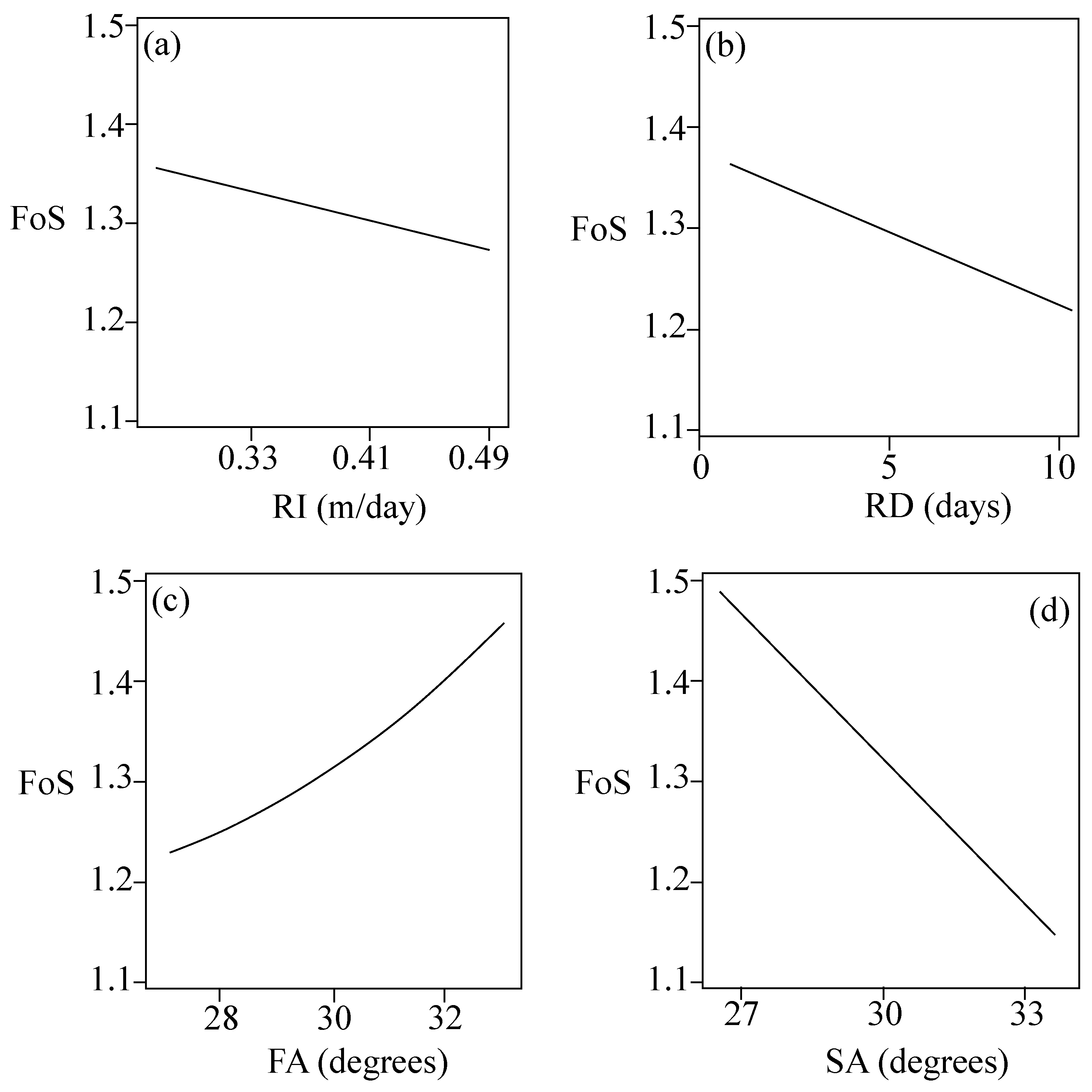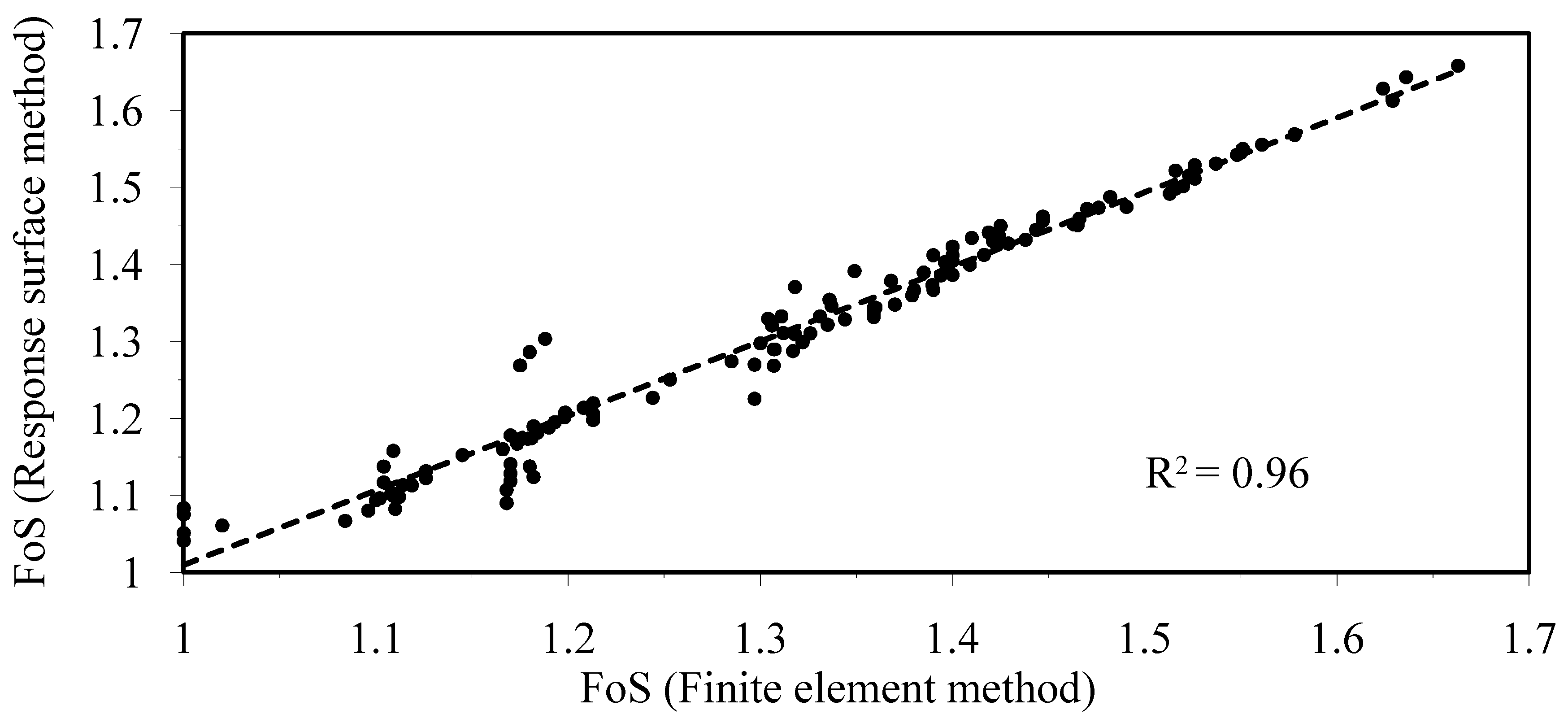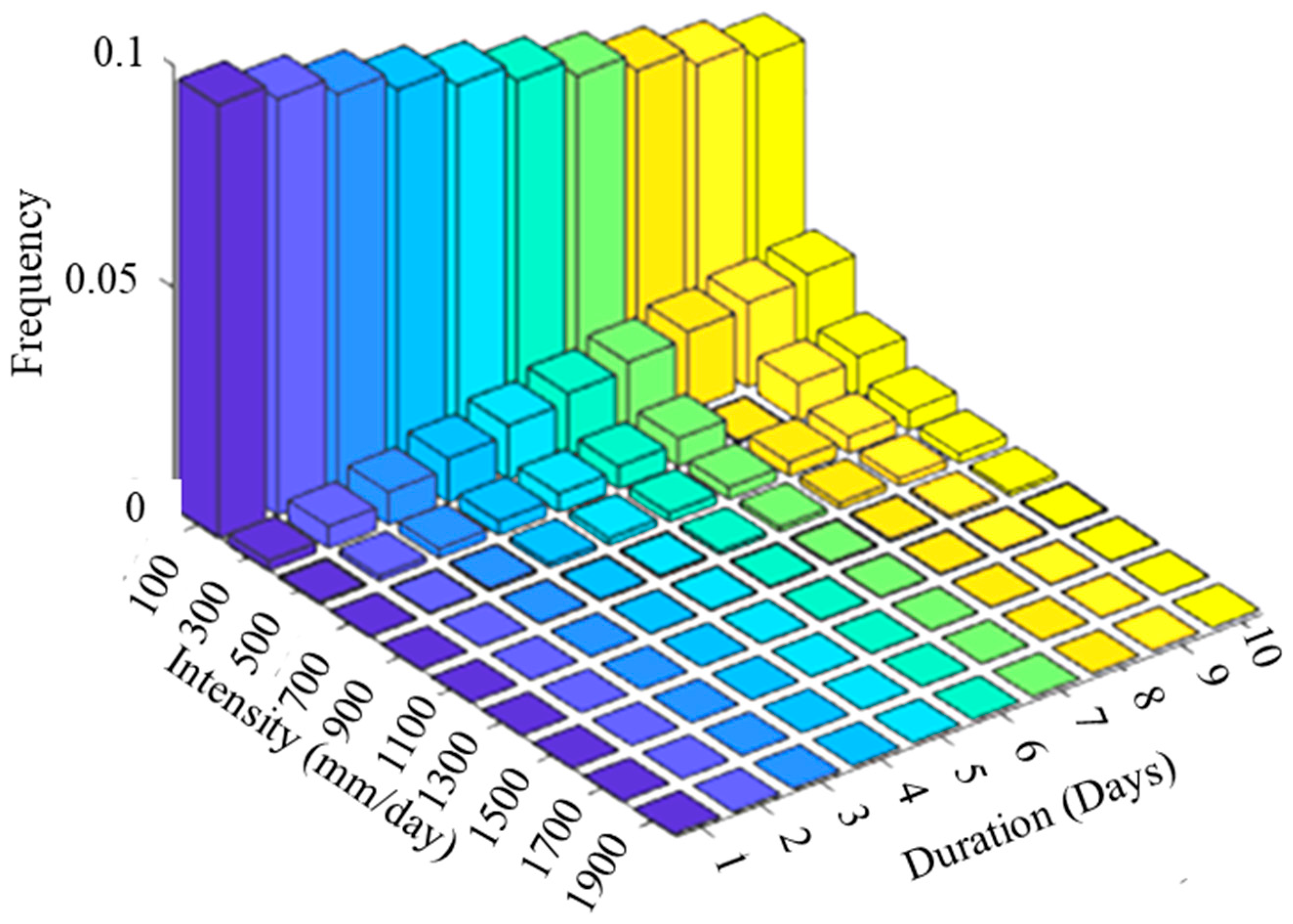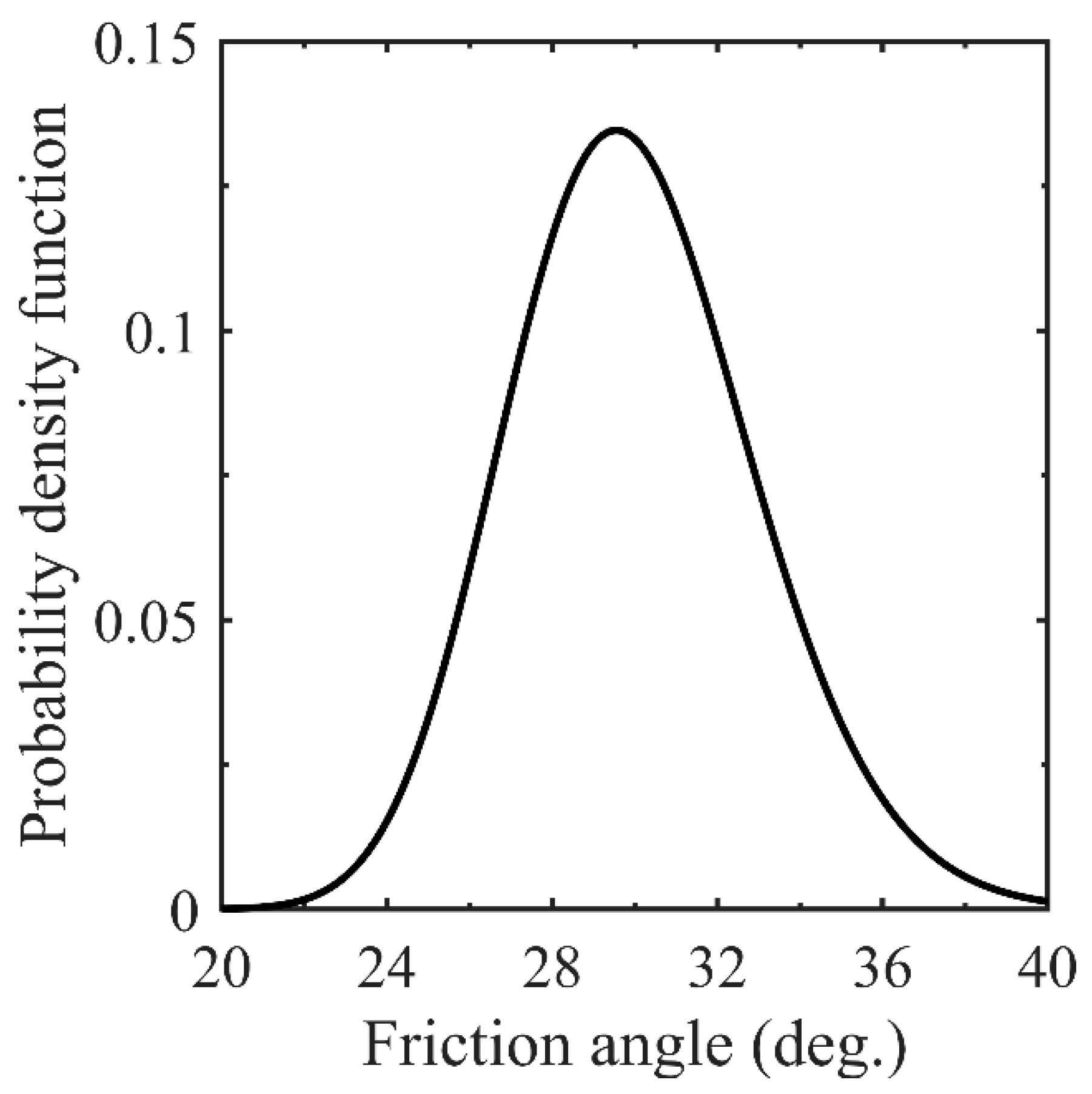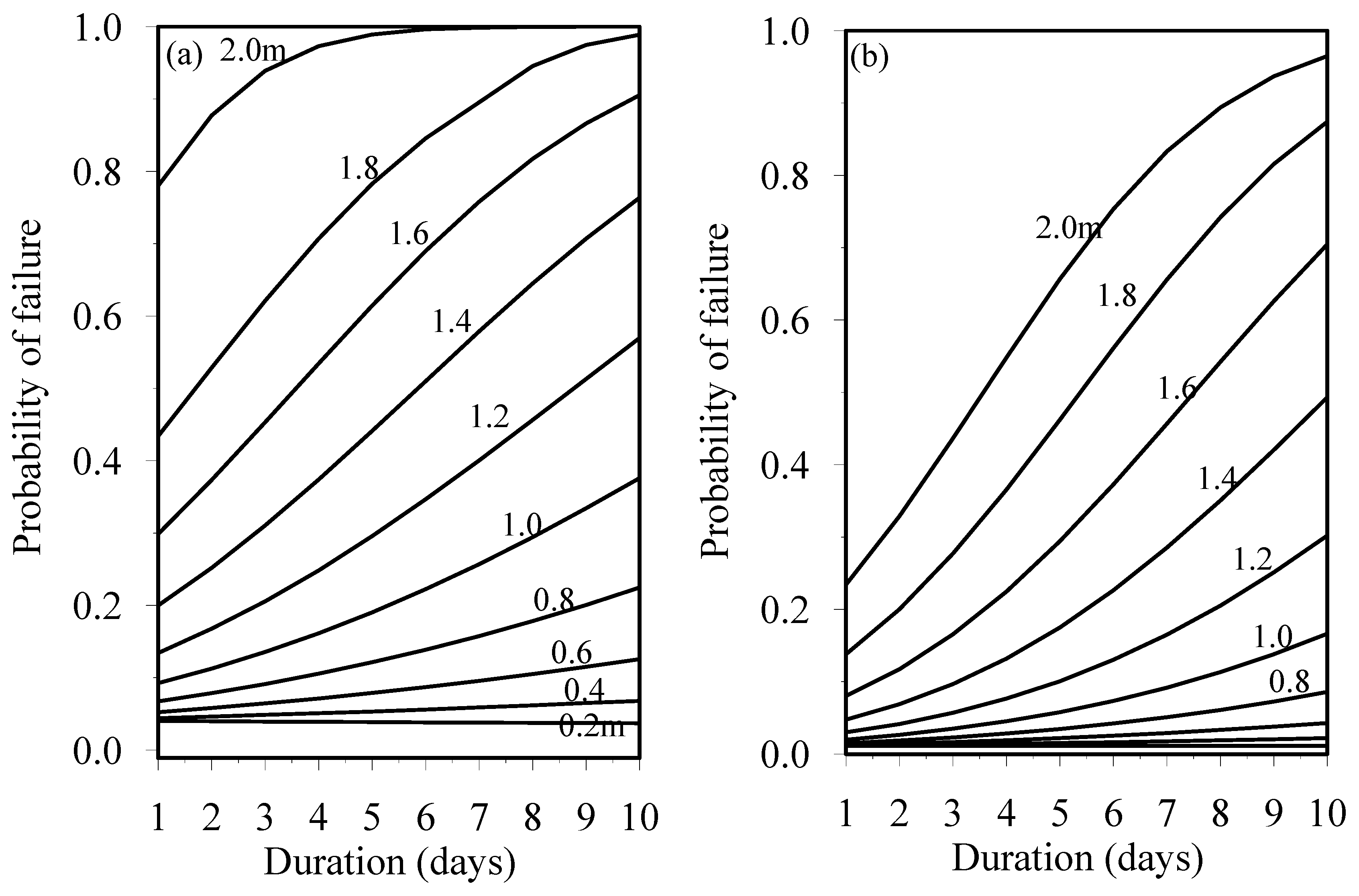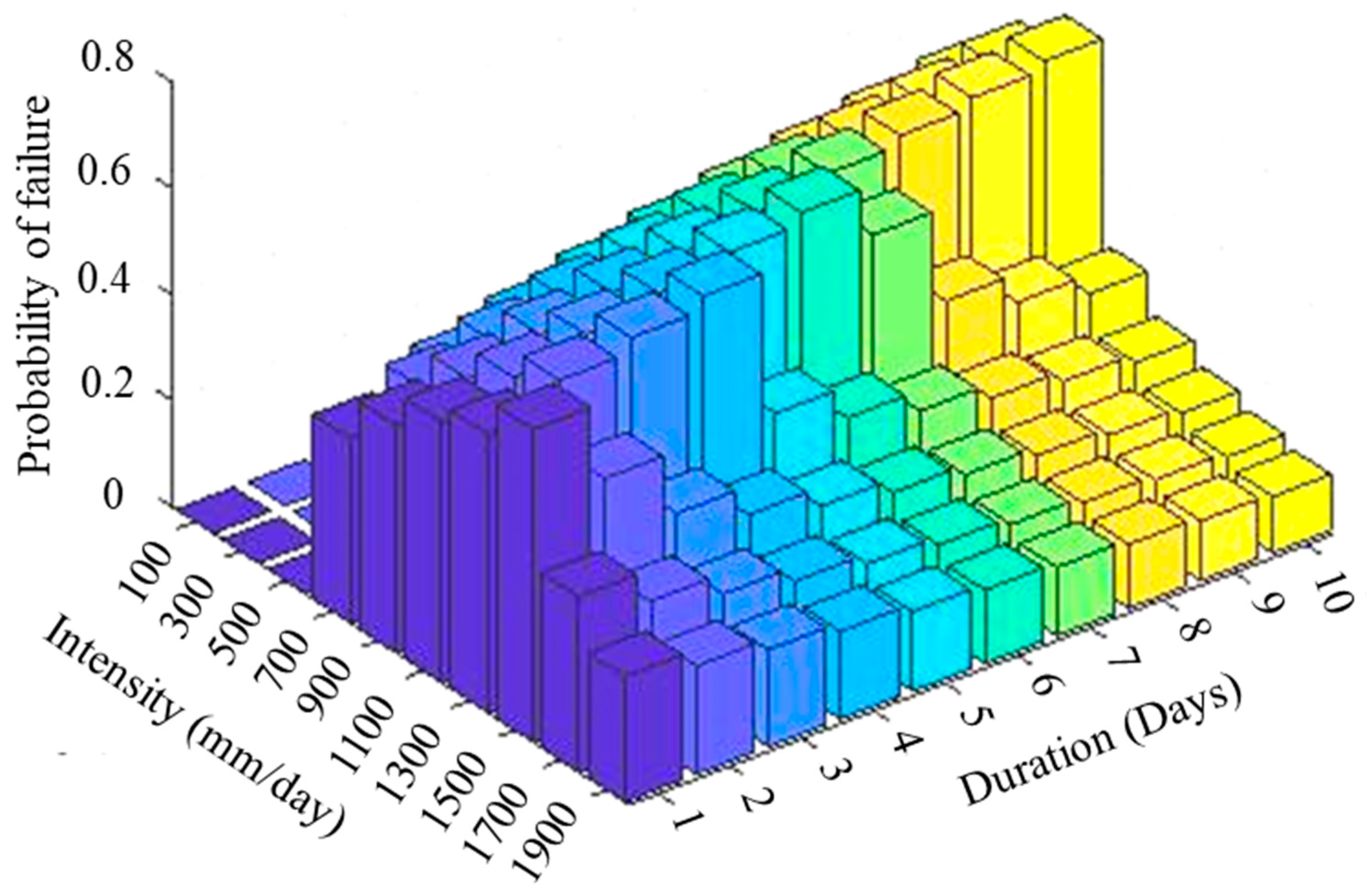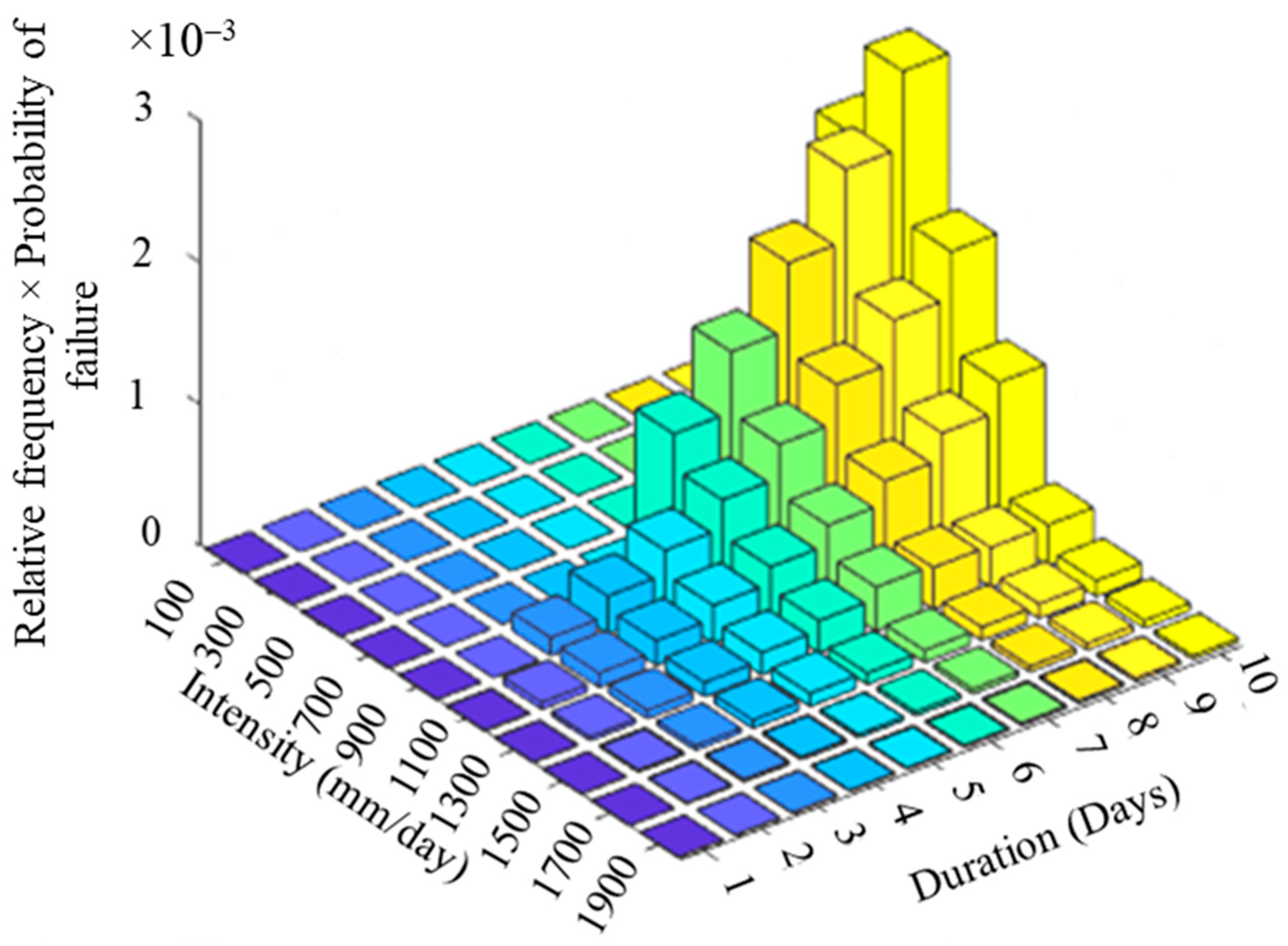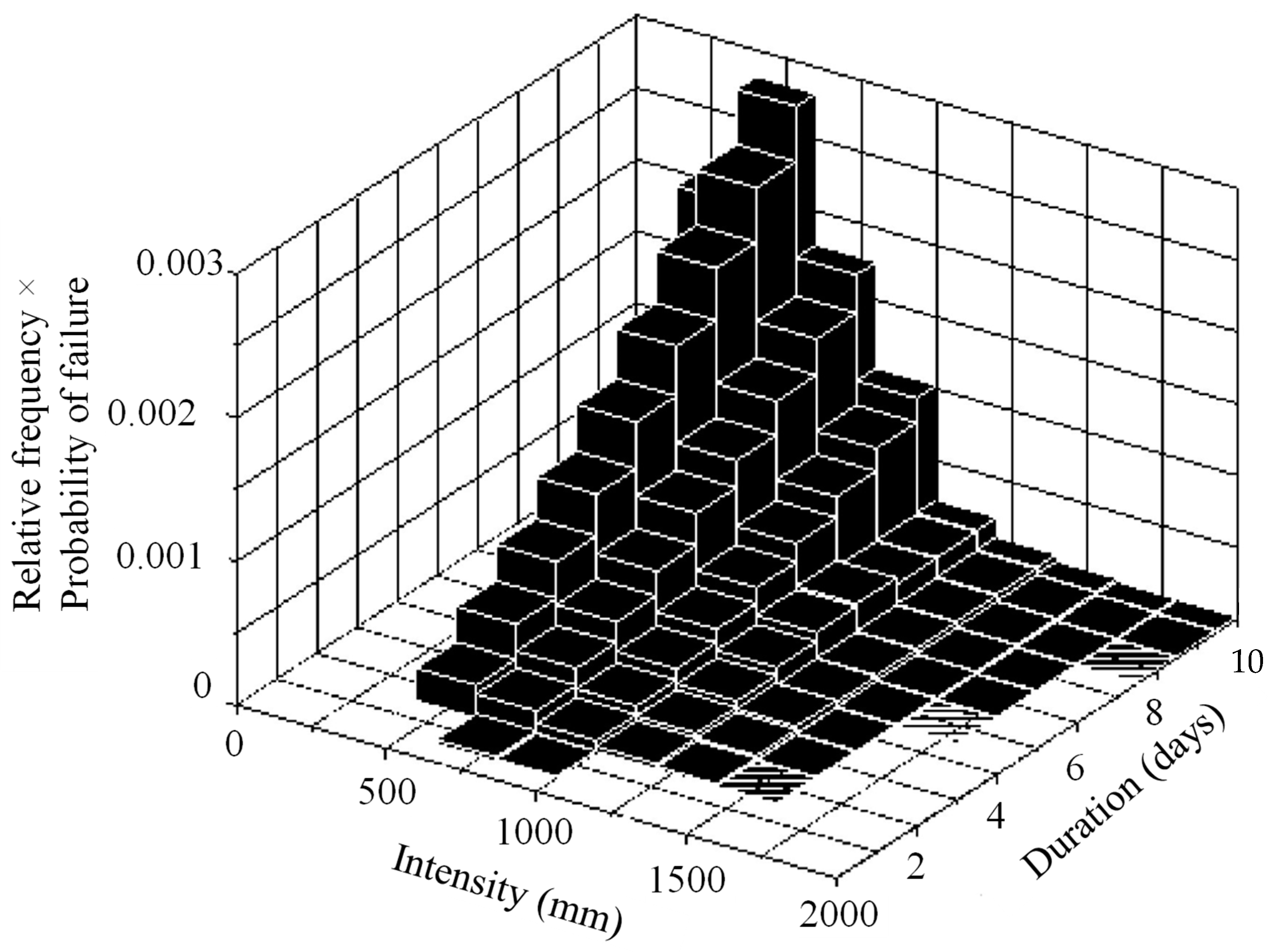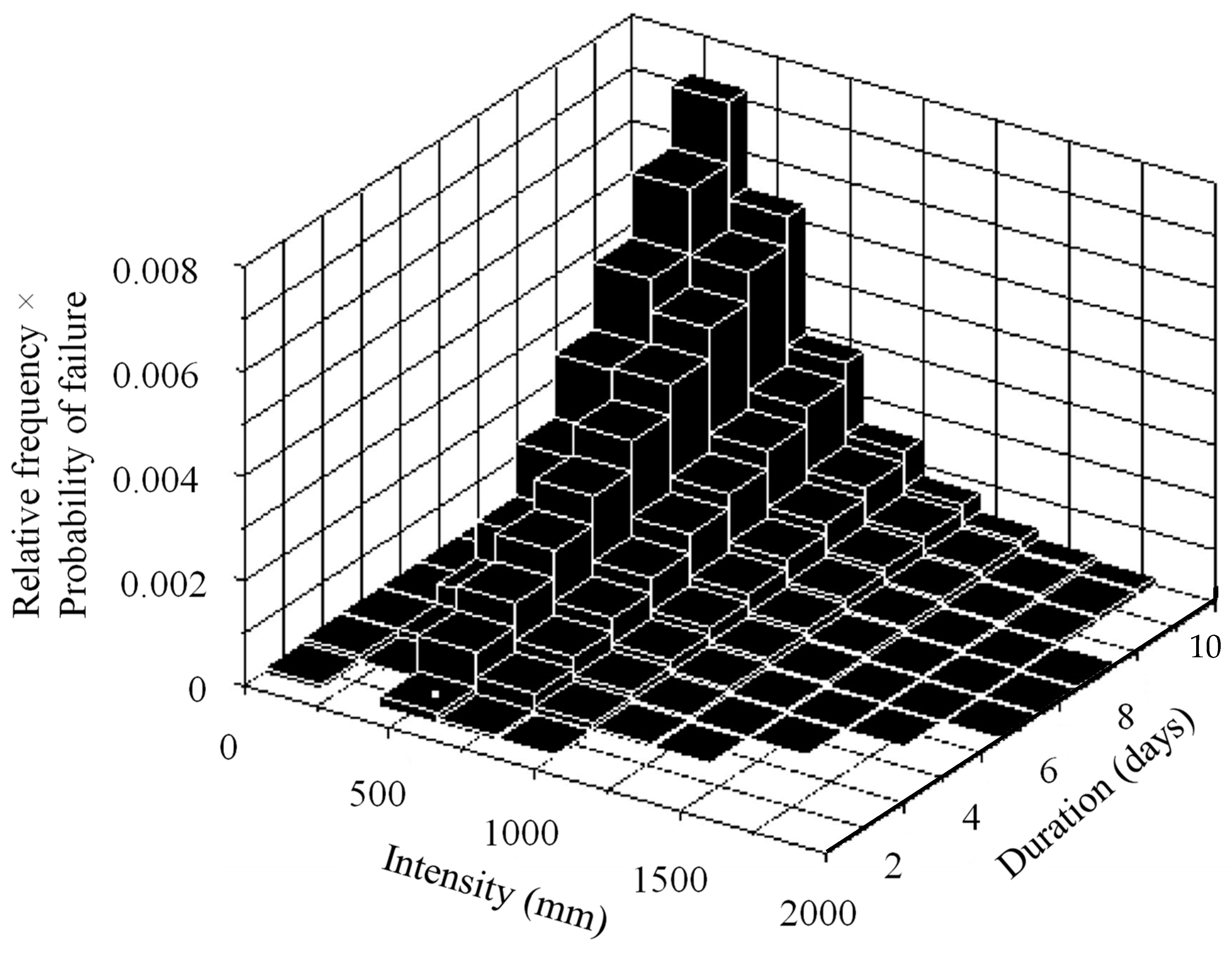1. Introduction
Recent studies have highlighted the increasing frequency of “climate whiplash” events—rapid transitions between extreme wet and dry conditions—due to global warming. This phenomenon has been linked to severe weather patterns in various regions, including intensified storms and prolonged droughts. These abrupt climatic shifts can significantly impact slope stability and failure mechanisms, as rapid soil saturation from heavy rainfall followed by drying periods can weaken soil structures, increasing the likelihood of instability and potential failure [
1]. Slope failure occurs due to various factors, including excessive rainfall, toe erosion, toe excavation, and external loading such as earthquakes. Understanding these failure mechanisms is critical for assessing stability under uncertain conditions.
Rainfall is a primary factor contributing to slope failures, as it increases pore water pressure, reduces effective stress, and alters soil strength properties [
2]. Numerous studies have emphasized the need for quantitative methods to assess slope stability under extreme rainfall conditions [
3,
4]. A comprehensive understanding of these mechanisms is essential for developing resilient geotechnical designs and effective landslide mitigation strategies. Estimating the stability of slopes due to rainfall is complex because water infiltration alters the strength and deformation properties of the slope soil in addition to the conventional pore pressure effect through the reduction in effective stress. The strength and deformation parameters of slope soil depend on the degree of saturation and/or matric suction, which varies with time and space during rainfall. The rate of movement of the wetting front depends on the hydraulic properties of the soil, the initial degree of saturation, the characteristics of the slope surface, and the intensity and duration of the rainfall. Generally, a slope’s safety (stability) is expressed by a factor of safety (FoS), which is typically determined using a limit equilibrium analysis. The conventional approach based on the limit equilibrium concept and classical soil mechanics principles followed by a parametric study may not accurately estimate the temporal variation in the stability (i.e., the onset of slope failure during a rainfall event) and the probability of failure for possible scenarios. In such situations, a coupled flow–deformation procedure combined with a probabilistic method that considers the possible variations in geometric, soil, and rainfall parameters can be used to estimate the stability of a slope systematically and accurately.
The coupled flow–deformation finite element method is well suited for conducting stability analysis of earth slopes under realistic scenarios. Among the many programs available in the literature, PLAXIS 2D, which has a coupled flow–deformation module with pressure head and flux boundaries, was successfully used by many researchers for evaluating the temporal variation in FoS [
5,
6]. While it assumes plane strain conditions and may not fully capture complex three-dimensional failure mechanisms, it remains more advanced than traditional limit equilibrium methods, providing a more realistic representation of soil behavior. Despite its limitations in handling highly heterogeneous or anisotropic soils, PLAXIS 2D offers a reliable and practical approach for assessing slope stability, making it a preferred choice for many geotechnical applications. Since there are several uncertainties in the computation of slope stability, the coupled flow–deformation finite element simulation alone cannot accurately predict the slope’s stability. In such situations, the more accurate deterministic finite element simulation results can then be coupled with probabilistic methods to consider the possible variations in the factors that affect the stability of a slope. The direct integration method, point estimate method, first-order second-moment method, FORM, and MCS are some of the probabilistic methods used by researchers for estimating the reliability of slope stability [
7,
8]. The MCS technique is widely used to calculate the probability of failure that analytical methods cannot readily solve. The advantage of using MCS is that it provides a simple framework for the reliability analysis of the system and can be used in repetitive executions to determine the FoS systematically [
9]. The MCS technique is robust to the finite element modeling (FEM) for system reliability analysis of geotechnical systems, including stability of slopes [
9,
10,
11,
12].
Several studies have been conducted to estimate the failure probability of earth slopes subjected to rainfall through mechanics-based models [
2,
11,
12,
13]. Among the many, Lu et al. [
11] proposed a mechanics-based approach to estimate the annual probability of slope failure subjected to rainfall in Singapore. Their study considered the uncertainty of soil properties and annual rainfall events. The yearly rainfall events were modeled through a bivariate distribution of intensity and duration, and the MCS was used to calculate the annual failure probability. They found that for the selected slope, the slip surface was deep when the rainfall duration was small, and the critical slip surface gradually moved to the upper wetted zone when the rainfall duration increased. Liu and Wang [
2] developed a probabilistic hazard analysis framework for rainfall-induced landslides, incorporating both rainfall uncertainty and soil spatial variability. They employed a fully Monte Carlo Simulation-based method to assess the annual slope failure probability at specific sites. Jiang et al. [
14] developed an efficient reliability analysis method based on MCS and limit equilibrium methods (LEM) to estimate the probability of slope failures in spatially variable soils. They concluded that the proposed method estimated the probability of failure considering the spatial variability of the cohesive soil properties while improving the computational efficiency at small probability levels.
The above studies indicate that the temporal variation in stability of slopes subjected to rainfall must be analyzed in a coupled manner incorporating the possible variations in system and loading characteristics. This study develops a probabilistic framework to systematically evaluate how slope geometry, soil strength properties, and varying rainfall intensities and durations influence slope stability. Unlike broad-scale landslide hazard assessments, this research focuses on the mechanical response of slopes by analyzing shear strain, stress variations, and probabilistic failure risks under different rainfall conditions.
To achieve this, the variables that affect the stability of the slope were identified, and their ranges were established. Then, PLAXIS 2D, a coupled flow–deformation finite element code, was used to simulate selected scenarios by systematically varying the random variables. The finite element results were then used to develop a mathematical relationship between the Factor of Safety (FoS) and the variables, called a response surface. Finally, the Monte Carlo Simulation (MCS) technique was used to calculate the probability of failure with the response surface, and the values obtained were validated using the First-Order Reliability Method (FORM) for future applications.
The novelty of this work lies in integrating deterministic finite element simulations with a response surface model to assess slope stability under uncertain rainfall conditions systematically. This approach provides a more comprehensive understanding of the influence of rainfall intensity and duration on slope failure, bridging the gap between numerical modeling and probabilistic assessment. This framework ensures robustness and reliability by validating results using both MCS and FORM, making it a valuable tool for geotechnical risk evaluation.
5. Probabilistic Analysis and Calculation of Probability of Failure
The probabilistic approach can systematically incorporate the uncertainties in soil properties and rainfall intensity and duration in the computation of slope stability for real-world applications. Among the many methods available in the literature for developing relationships between more than one variable, the response surface method (RSM) has been proven to be a computationally efficient method for slope stability analysis and other engineering problems [
23]. Kumar et al. [
24] applied Response Surface Methodology (RSM) to assess the stability of three real-world rock slopes with varying failure mechanisms, demonstrating its effectiveness in reliability-based slope analysis. By comparing RSM-based reliability estimates with Monte Carlo Simulation (MCS), the study confirmed the accuracy and computational efficiency of different response surface techniques, providing guidelines for selecting the most suitable RSM approach for practical geotechnical applications. Li et al. [
23] evaluated the computational accuracy and efficiency of various response surface methods (RSMs) for different types of slope reliability problems, confirming their applicability in real-world geotechnical assessments. The study demonstrates that RSMs provide reliable and computationally efficient alternatives for slope stability analysis under uncertainty by comparing single and multiple response surface approaches across multiple-layered and spatially variable soil conditions. RMSs involve fitting a polynomial model to the observed data (computed data in this case) and using it to find the response (FoS in this case) over a wide range of independent variables.
5.1. Development of Response Surface
The FoS were calculated based on 170 coupled flow–deformation finite element simulations considering several scenarios by varying the slope ratios, friction angles, rainfall intensities, and rainfall durations (random variables). The FoS was then expressed as a function of random variables using multiple linear regression of approximation, as shown in Equation (4). Among the many models commonly used for developing a response surface, the second-order polynomial model was used in the study. Equation (4) has fourteen coefficients (1 constant, 4 linear term coefficients, 6 two-factor interaction coefficients, and 3 quadratic term coefficients).
where
SA is the slope angle (in degrees),
RI is the rainfall intensity (in m/day),
RD is the rainfall duration (in days), and
FA is the friction angle (in degrees). As expressed in Equation (4), the second-order polynomial model was selected to capture the nonlinear relationships among the random variables influencing the Factor of Safety (FoS), including slope angle, rainfall intensity, rainfall duration, and soil friction angle. The coefficients of the model were estimated using multiple linear regression based on 170 coupled flow–deformation finite element simulations covering a wide range of parameter variations.
To assess the significance of each variable, a standardized Pareto chart was generated (
Figure 11). This chart highlights the dominant effects of slope angle (61%) and friction angle (36%) on the response, while rainfall intensity and duration showed relatively lower influence. The Pareto chart was derived to show the impact of each variable considered in this study. Regarding the effect of individual random variables, it is clear that
SA has the strongest influence on FoS (61). The next influential variable is the
FA, which shows almost ¾th impact (36) compared to
SA. The
RI has the least influence on slope stability compared to the other random variables. The quadratic relation of
FA and
RD showed the least impact on the FoS.
The influence of each random variable on FoS is shown in
Figure 12. From the figure, the impacts of RI, RD, and SA on FoS are linear, while FA is nonlinear. It is also observed that the FoS decreases with RI, RD, and SA while it increases with FA.
The second-order polynomial model effectively approximates the behavior of the system, as demonstrated by the high R
2 value (0.96) when comparing the modeled and simulated FoS values (
Figure 13). This ensures the reliability of the model for subsequent probabilistic analyses.
Figure 13 compares the FoS calculated from the response surface equation (Equation (4)) and computed from the finite element method. A high R
2 value (0.96) shows that the mathematical model fits the data generated from the finite element method reasonably well and can be used for further study.
5.2. Bivariate Distribution of the Probability of Rainfall Intensity and Duration
The daily rainfall data from 1979 to 2020 for 3812 stations in the US was obtained from Global Historical Climatology Network Daily (GHCNd). The relative frequency of intensity and duration were obtained from this rainfall data, as shown in
Figure 14. The results show that the frequency of the lowest rainfall intensity (200 mm/day) with the shortest duration (1 day) was higher than the other rainfall intensity and duration combinations. The lowest frequency was obtained for the higher intensity (2000 mm/day) and most prolonged duration (10 days). Therefore, this study adopts the bivariate distribution of intensity and duration to calibrate the uncertainty performance with daily rainfall events.
5.3. Calculation of Probability of Failure Using Monte-Carlo Simulation
The response surface developed in the previous section was used to calculate the probability distribution of FoS for a wide range of random variables. The Monte Carlo Simulation (MCS) approach was implemented to estimate the probability of failure, defined as the conditional probability of failure for given combinations of rainfall intensity and duration. The MCS procedure consisted of two main steps. First, 10,000 random samples of each random variable (rainfall intensity, rainfall duration, and soil friction angle) were generated. These samples were drawn from a log-normal distribution, which is commonly used in geotechnical engineering due to its ability to represent non-negative variables and capture the natural variability of soil properties. The log-normal distribution was selected because soil parameters, particularly friction angle, and permeability, often exhibit a positively skewed distribution in field measurements. After generating the random samples, each sample was substituted into the response surface function (Equation (4)) to compute the corresponding FoS values. This probabilistic approach enabled the estimation of failure probabilities under various rainfall conditions. The probability of failure in this study was then calculated using the equation shown in Equation (5). The impact of input distribution variations was further assessed through sensitivity analysis, ensuring that the probabilistic results remained representative of real-world geotechnical conditions.
where
is the probability of failure,
is the indicator function (Equation (4)),
is the uncertainty parameter (random variable),
is the number of random samples, and
is the number of failure samples. In the Monte Carlo Simulation (MCS) procedure, 10,000 random samples of input parameters were generated using the Latin Hypercube Sampling (LHS) technique to ensure statistical robustness and efficient representation of variability. The soil friction angle was assumed to follow a log-normal distribution with a mean of 300 and a standard deviation of 30, as variations in grain size, density, and compaction naturally lead to this distribution for sandy soils. This choice aligns with published studies that indicate friction angles for sandy soils typically exhibit log-normal behavior. To ensure a realistic representation of field conditions, random values were generated within a broader range of 200 to 400, extending beyond the values used in finite element simulations, thereby accounting for potential variability observed in geotechnical practice. Rainfall intensity and duration were modeled using a bivariate distribution to capture their statistical dependence based on historical rainfall data, as shown in
Figure 15. Sensitivity analysis confirmed that slope angle and soil strength parameters had the highest influence on stability, while rainfall variations contributed to increased uncertainty in failure probabilities. By incorporating well-calibrated distributions and a wide range of values, the probabilistic framework enhances the reliability of failure probability estimates, making the approach more applicable to practical geotechnical risk assessments.
5.4. Procedure for Determining the Total Probability of Failure
The probability of failure for rainfall-induced slope instability was estimated by calculating the number of failures using Equation (4), where FoS falls below 1 for different rainfall intensity, duration, and friction angles. The probability of failure was obtained separately for both slope ratios.
Figure 16 shows the procedure adopted for calculating the probability of failure.
Figure 17a,b show the calculated probability of failure for each intensity and duration for SR1 and SR2 at randomly selected friction angle values using MCS.
Figure 18 shows that the probability of failure for intensity 2000 mm/day was higher than the other intensities. The lowest failure probability of failure, 0.037, was obtained for the intensity of 200 mm/day.
Figure 18 shows the calculated probability of failure for each combination of rainfall intensity and duration for SR1. The jointed distribution for rainfall intensity and duration indicated that the probability of failure for intensities 200 and 400 mm/day was almost 0. This indicates that there is almost no chance of failures for the SR1 for the intensities 200 mm/day and 400 mm/day for the selected range of friction angle. The maximum probability of failure of 0.6457 was obtained for the rainfall intensity of 1000 mm/day for 10 days. The probability of failure distribution of rainfall intensity and duration indicated that the maximum failure probability for SR1 occurred from 600 to 1400 mm/day.
Figure 19 shows the probability of failure for SR2 at different rainfall intensities and durations. The maximum probability of failure of 0.5891 was observed for the intensity of 1400 mm/day and duration of 10 days. It was also observed that the probability of failure is generally high from 800 to 2000 mm/day rainfall intensity. There was little chance of failure between 200 and 800 mm/day rainfall intensity. These results coincided well with the parametric study results shown in
Figure 8.
From the calculated probability of failure and the frequency of rainfall intensity and duration, the total probability of failure was calculated based on the total probability theorem as shown in Equation (6).
The values of the probability of failure multiplied by the relative frequency for rainfall intensity and duration (as expressed in
Figure 14) for SR1 and SR2 are shown in
Figure 20 and
Figure 21, respectively. The total probability of failure was calculated by summation of the conditional probability of failure multiplied by the relative frequency for rainfall intensity and duration, as shown in Equation (6). The total probability of failure for the SR1 and SR2 slopes are 0.0633 and 0.0249, respectively.
5.5. Comparison with FORM for the Total Probability of Failure Evaluation
In this section, the MCS was replaced with the First-Order Reliability Method (FORM) to evaluate the conditional probability of failure for the given combination of rainfall intensity and duration. FORM is a probabilistic analysis technique used to assess the reliability of engineering structures and systems. It was widely used in slope engineering to consider the uncertainties in input parameters such as soil properties and rainfall conditions.
Following a similar procedure, the probability of failure for the given combination of rainfall intensity and duration can be obtained using the response surface shown in Equation (4). The values of the probability of failure multiplied by the relative frequency for rainfall intensity and duration (as expressed in
Figure 14) for SR1 and SR2 are shown in
Figure 22 and
Figure 23, respectively. Finally, the total probability of failure was evaluated using Equation (6), and the total probability of failure for the SR1 and SR2 slopes using FORM are 0.0640 and 0.0229, respectively.
The results in
Figure 20 and
Figure 21, derived from Monte Carlo Simulation (MCS), show some differences compared to the results in
Figure 22 and
Figure 23, which are based on the First-Order Reliability Method (FORM). Some minor differences exist due to some approximations used in the FORM algorithm. MCS evaluates the probability of failure by sampling across the entire probability distribution of the input variables, providing a robust and comprehensive estimate. On the other hand, FORM approximates the limit-state function by linearizing it at the most probable point of failure. While FORM is computationally efficient, it may not capture the full variability of the system, particularly in cases involving complex nonlinear relationships, as seen in rainfall-induced slope failures. This methodological distinction explains the minor discrepancies, and both results are included to provide a broader understanding of slope reliability under rainfall conditions.
Table 3 summarizes the probability of failure values obtained from MCS and FORM. For the SR1, the probability of failure obtained using MCS and FORM were 0.0633 and 0.0640, respectively. Most geotechnical systems require a probability of failure less than 0.023 for an expected performance level better than poor [
25,
26]. The 0.023 probability of failure threshold is widely used in geotechnical practice to distinguish acceptable and critical slope performance levels. However, its applicability varies based on soil type, geological conditions, and risk tolerance. A lower threshold may be needed in soft clays or weathered rock formations, whereas denser sands and well-compacted soils can tolerate slightly higher values due to their inherent stability. The selection of an appropriate threshold should consider site-specific geological, environmental, and design factors. According to the U.S. Army Corps of Engineers [
25], the obtained values of 0.0633 and 0.0640 lie between the expected performance levels of poor and unsatisfactory. This shows that the performance level for SR1 is close to unsatisfactory. Similarly, for SR2, the probability of failure values obtained from MCS and FORM were 0.0249 and 0.0229, respectively. These show closer value to the performance level of the poor.
The U.S. Army Corps of Engineers (USACE) standard provides established guidelines for slope stability assessment, primarily using deterministic Factor of Safety (FoS) calculations. While widely applied in engineering practice, these standards do not explicitly incorporate probabilistic methods for failure risk evaluation under variable conditions. Integrating probabilistic approaches within USACE guidelines can enhance risk-based assessments, particularly for climate-induced slope failures. However, aligning these methods with existing regulatory frameworks remains a challenge, requiring further collaboration with engineering authorities for broader implementation.
Although the probability of failure values obtained using MCS and FORM are relatively close, the discrepancies arise primarily from the assumptions made in FORM regarding the linearization of the limit state function. FORM is a computationally efficient method that provides rapid reliability estimations, making it suitable for large-scale geotechnical applications. However, its reliance on a linearized limit state function can lead to either overestimation or underestimation of failure probability, particularly in cases involving highly nonlinear failure surfaces, such as those influenced by extreme rainfall conditions. On the other hand, MCS provides a more robust estimation by fully accounting for the variability in input parameters and capturing nonlinear failure mechanisms. However, MCS is computationally demanding, requiring a large number of simulations to achieve convergence, which can be impractical for real-time risk assessments. The comparison of these two methods in this study was conducted to evaluate their applicability in slope stability analysis, highlighting the trade-offs between computational efficiency and accuracy. Future research should focus on refining response surface modeling techniques and exploring alternative probabilistic approaches, such as subset simulation or importance sampling, to enhance computational efficiency while maintaining accuracy in failure probability estimation.
6. Conclusions
A general probabilistic framework for calculating the probability of failure of slopes subjected to rainfall is proposed. The uncertainties associated with the shear strength parameter, friction angle, rainfall intensity, and duration are systematically considered. The stability of the slopes subjected to rainfall was evaluated using finite element coupled flow–deformation code, PLAXIS 2D, and a response surface for the FoS was developed based on the computed results. Then, using the formulated response surface, the failure probability was determined using MCS and FORM. The probability of failure values obtained from MCS and FORM were 0.0633 and 0.0640, respectively, for SR1, and 0.0249 and 0.0229, respectively, for SR2. The probability of failure for SR1 and SR2 shows the performance level is unsatisfactory or poor for the studied slope under uncertain rainfall conditions. The proposed framework can be used as a valuable tool to evaluate the performance level in terms of the probability of failure for slopes subjected to uncertain rainfall conditions.
The proposed probabilistic framework integrates deterministic finite element simulations with Monte Carlo Simulation (MCS) to systematically assess slope stability under uncertain rainfall conditions. The findings highlight the importance of incorporating probabilistic methods to better capture rainfall-induced slope failure mechanisms. While the methodology enhances the accuracy of failure probability estimation, several challenges remain for practical implementation. These include computational demand, reliance on high-resolution data, and the need for regulatory adaptations to support risk-based design. Future research should focus on optimizing computational efficiency and incorporating real-time monitoring data to improve model applicability in engineering practice.
Future research should focus on extending the proposed probabilistic framework to various slope stability scenarios, including seismic loading, rapid drawdown, and anthropogenic influences such as excavation and external loads. Integrating real-time monitoring data, such as pore-water pressure and slope displacement measurements, can enhance failure prediction accuracy and support early warning systems. Additionally, improving computational efficiency through advanced probabilistic methods, such as subset simulation or machine learning-based surrogate models, would make the framework more practical for large-scale applications. Incorporating spatial variability of soil properties and rainfall patterns can further refine slope stability assessments, providing more realistic predictions. Lastly, validating the framework with real-world case studies across different geological settings will strengthen its applicability and reliability for engineering practice.
